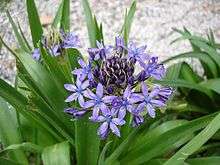Scilla peruviana
| Portuguese squill | |
|---|---|
 | |
| Scientific classification | |
| Kingdom: | Plantae |
| Clade: | Angiosperms |
| Clade: | Monocots |
| Order: | Asparagales |
| Family: | Asparagaceae |
| Subfamily: | Scilloideae |
| Genus: | Scilla |
| Species: | S. peruviana |
| Binomial name | |
| Scilla peruviana | |
| Synonyms | |
|
Many, including: | |
Scilla peruviana, the Portuguese squill,[4] is a species of Scilla native to the western Mediterranean region in Iberia, Italy, and northwest Africa.[5]
Although the epithet peruviana means "from Peru", it is strictly a western Mediterranean species. Linnaeus named the species in 1753, noting an earlier name given to the plant by Carolus Clusius, Hyacinthus stellatus peruanus.[6] It is said that Clusius misunderstood a statement that the bulbs came from a ship called "Peru" and thought that they came from the country.[7]
It is a bulb-bearing herbaceous perennial plant. The bulb is 6–8 cm diameter, white with a covering of brown scales. The leaves are linear, 20–60 cm long and 1–4 cm broad, with 5-15 leaves produced each spring. The flowering stem is 15–40 cm tall, bearing a dense pyramidal raceme of 40-100 flowers; each flower is blue, 1–2 cm diameter, with six tepals.
Cultivation and uses
It is commonly grown as an ornamental plant for its spring flowers; several cultivars are available ranging in colour from white to light or dark blue, or violet. In some areas it is also known as hyacinth-of-Peru,[5] Cuban-lily,[5] or Peruvian scilla.
References
- ↑ L. Sp. Pl. 309 (1753)
- ↑ Jord. & Fourr. Icon. Fl. Eur. 2: 16 (1869)
- ↑ Maire & Weiller Fl. Afr. Nord N. 5: 144 (1958)
- ↑ "BSBI List 2007". Botanical Society of Britain and Ireland. Archived from the original (xls) on 2015-01-25. Retrieved 2014-10-17.
- 1 2 3 "Scilla peruviana". Germplasm Resources Information Network (GRIN). Agricultural Research Service (ARS), United States Department of Agriculture (USDA). Retrieved 30 June 2013.
- ↑ Linnaeus, C. (1753). Species Plantarum. 1. Stockholm: Laurentius Salvius. p. 309.
- ↑ Schauenberg, Paul (1965). The Bulb Book. London: F. Warne. p. 248. OCLC 745287745.